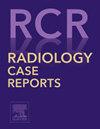Acute rupture of a huge liver hydatid cysts in the peritoneal cavity causing an anaphylactic shock: A case report
Q4 Medicine
引用次数: 0
Abstract
The rupture of hepatic hydatid cysts into the peritoneal cavity is an uncommon but life-threatening condition that can result in complications such as peritonitis and anaphylactic shock. This report describes the case of a 39-year-old diabetic male who presented with acute epigastric pain, fever (39°C), and abdominal rigidity. Imaging studies revealed pneumoperitoneum and the rupture of a large hepatic hydatid cyst measuring 20 × 30 cm located in the right lobe of the liver. Emergency laparotomy confirmed the rupture, and surgical management involved peritoneal lavage and initiation of antiparasitic therapy. The patient recovered fully and was discharged 23 days after surgery. Rupture of hepatic hydatid cysts occurs in only 1%-2% of cases and is often associated with large cyst size (>10 cm) and superficial location. Early imaging, particularly with CT, is crucial for diagnosis, while surgical intervention aims to manage the rupture, prevent further complications, and address residual cysts. This case highlights the significance of prompt diagnosis and management to avoid severe outcomes such as secondary peritoneal hydatidosis and anaphylactic shock.
求助全文
约1分钟内获得全文
求助全文
来源期刊

Radiology Case Reports
Medicine-Radiology, Nuclear Medicine and Imaging
CiteScore
1.10
自引率
0.00%
发文量
1074
审稿时长
30 days
期刊介绍:
The content of this journal is exclusively case reports that feature diagnostic imaging. Categories in which case reports can be placed include the musculoskeletal system, spine, central nervous system, head and neck, cardiovascular, chest, gastrointestinal, genitourinary, multisystem, pediatric, emergency, women''s imaging, oncologic, normal variants, medical devices, foreign bodies, interventional radiology, nuclear medicine, molecular imaging, ultrasonography, imaging artifacts, forensic, anthropological, and medical-legal. Articles must be well-documented and include a review of the appropriate literature.
 求助内容:
求助内容: 应助结果提醒方式:
应助结果提醒方式:


